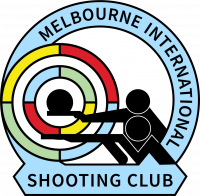History of Pistol Shooting in Victoria
The inclusion of Free Pistol (50M Pistol) and Silhouette (Rapid Fire) events in the 1956 Olympic Games program was the impetus for the beginning of pistol shooting in Victoria. Prior to this, it was illegal to have a pistol in Victoria after 1920 unless you could obtain a licence – and there was not easy to get.
At that time only Tasmania and South Australia allowed pistol shooting clubs to exist and as the Adelaide Pistol Club had the only Australian affiliation with the International Shooting Union (UIT) it was proposed to run the pistol events in Adelaide. This idea was dismissed as it was preferred that the events be run in Victoria as part of the Games. The Firearms Act, which did not allow the registration of pistols less than 0.25 inch, was amended in December 1955 to permit the registration of “target pistols of a type used at the Olympic Games”. That amendment expired on 31 December 1956 at which time pistol shooting with .22’s would once again becoming illegal and no licenses had been issued for centre fire pistols for target shooting.
The Victorian Sporting Shooters Association Pistol Club was formed at a meeting held on 23 May 1955 to give Victorian shooters an opportunity to participate in the pistol events at the Olympic Games. This date is commemorated each year in our Anniversary shoot. To gain experience in pistol shooting a range used by the Police at their barracks in St Kilda Road was extended to about 20 metres and the manure pit (the police horses were also located at this site) relocated. A Hi-Standard pistol previously confiscated from one of our members was seconded from the Police Museum as the first club pistol. A photo of this is held in the MISC clubhouse. Members would line up with five rounds in their hand to take turns at shooting this exclusive pistol. At the end of the Olympic Games, this pistol was returned to the Police Museum and in comparatively recent times, and after considerable negotiations, the Police returned the pistol to the original owner as a souvenir of his sporting achievements.
The second club pistol was a new Webley and Scott single-shot pistol that the grapevine located. Originally belonging to a returned airman, this was purchased and served alongside the Hi-Standard. Both pistols had to be locked up in a Police safe and booked out by club officials when needed each weekend. A set of hand lever operated turning targets were installed so our shooters could get experience at rapid-fire. The first target pistol competition was run at the barracks soon after the formation of the club.
In January 1956, at a meeting in Mount Gambier, it was proposed that the Amateur Pistol Shooting Union of Australian formed by South Australia, Victoria and Tasmania. Problems arising from S.A.’s request to be given majority voting rights were resolved by the later formation of the NSW Pistol Shooting Association, which was then offered membership and thus having a minimum of three State bodies as required by the Australian Olympic Federation for affiliation to that body.
The actual Game’s events were shot at temporary ranges set up on the Williamstown Rifle Range (now sadly no more). Free Pistol was won by P.T. Linnosvuo of Finland with 556 (26 x 10) on a countback of bulls from M. Oumarov of USSF (24 x 10). Rapid Fire (Silhouette) was won by S. Petrescu of Romania with a new world record of 587. The Australian team was Rod Johnson (MISC) and Len Tolhurst (Adelaide) in free pistol, with Peter Papps (Adelaide) and John Maitland (MISC) in rapid-fire.
The rapid-fire event saw the introduction of the upside-down hacksaw pistol by E. Tcherkassov of U.S.S.R. which upset the purists who thought that pistols should look like pistols. To overcome this problem the pistol box rules (which measure the overall dimensions of handguns) were brought in.
The original VSSA Pistol Club split up to form three clubs: Melbourne, Dandenong (which later became Yarra) and a third club which never eventuated. The Victorian Amateur Pistol Association (VAPA) was formed to oversee and supervise the pistol clubs in the state – a task it still manages today.
At the end of 1956, all the temporary pistol licences expired so club members with pistols were given three-month disposal notices. This procedure was repeated every three months, until eventually the Firearms Act 1958 came into operation on 1 April 1959 which allowed registration of .22 calibre pistols and twelve-month licences were issued.
Use of the facility at the Police barracks by club members was withdrawn so a new range site was needed. In this quest, the Melbourne Pistol Club moved to a deep clay quarry in Brunswick, which was the local rubbish tip. Fixed targets were set up here and much practice was undertaken. Members were able to purchase their own pistols at this stage and after about two years the club moved to a granite quarry at Albion where it flourished to become the largest club in the state. The Albion quarry closed in 1976 whereupon the club moved to its present site at Port Melbourne after amalgamating with the Springvale International Shooting Club to become the Melbourne International Shooting Club.
…oooOOOooo…
Extract from the minutes of the Committee Meeting of the M.P.C. held 16 August 1955.
Mr Davies moved, seconded by Mr J. Smith that the following list of members is recommended to the Police as being suitable in our eyes to own their own pistols subject to Police Confirmation.
J. Maitland J. E. Davies
R. Batrouney J. Herring
V. Bennett P. Carr
N. Hall ) GOOD SHOOTERS
R. Johnson
G. Rogers
R. Runge, W. Albert, D. Rogers, H. Scott, W. Maynard ) GUN DEALERS
Note: The licences for these pistols were not received until early December 1955.
